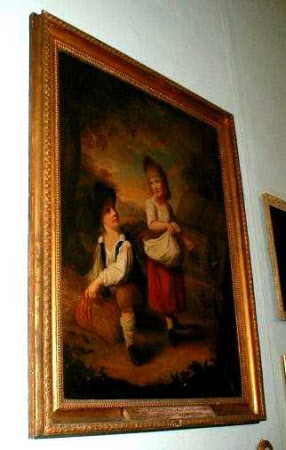The Hon. Sir Edward Cust, later 1st Baron Cust of Leasowe Castle, Cheshire and his sister the Hon. Anne Cust, later Lady Middleton (d.1867) as Children
The Hon. Elizabeth Cust (1776 - 1858)
Category
Art / Oil paintings
Date
1799 (dated on reverse)
Materials
Oil on canvas
Measurements
1520 x 1270 mm
Place of origin
England
Order this imageCollection
Belton House, Lincolnshire
NT 436171
Summary
Oil painting on canvas, The Hon. Sir Edward Cust, later 1st Baron Cust of Leasowe Castle, Cheshire and his Sister the Hon. Anne Cust, later Lady Middleton (d.1867) as Children by The Hon. Elizabeth Cust (1776-1858), inscribed and dated 1799 on the reverse.Both full-length portraits and depicted as children gleaners in a farmyard. Edward Cust was the sixth son of 1st Lord Brownlow; created baronet 1876. He lived at Leasowe Castle, Cheshire; father of Victoria Cust, who married Simon Yorke III in 1846; General, courtier, military historian, and Christian write; fought in the Peninsular War, but never saw active service again; when he died, he was almost the last surviving officer from it. In 1816 Prince Leopold of Saxe-Coburg appointed him his equerry, and subsequently Master of his Household, a post that he held until Leopold became King of the Belgians in 1831, retaining his confidence thereafter. Tory MP for Grantham 1818-26, and for Lostwithiel from then until its suppression under the Reform Bill in 1832. He took an active part in securing the principle of open competition for public architectural commissions, and became a commissioner for the rebuilding of the Houses of Parliament, and for the design of the Wellington Monument. In 1846 he was appointed Assistant Master of Ceremonies to Queen Victoria, and in 1847 Master, securing the friendship of the sovereign, and retaining the post until his retirement in 1876, when he was rewarded with a baronetcy. His military histories won him a gold medal from the Emperor Franz Joseph, whilst his, 'Noctes Dominicae, or Sunday Night Readings' (1848), and 'Family Readings - the New Testament harmonised and explained' (1850) brought him an honorary DCL from Oxford in 1853. His wife, Mary Anne Boode, only child of Lewis William Boode, of Amsterdam and Peover Hall, Cheshire, and heiress of her mother, Margaret Dannett of Leasowe Castle, Birkenhead, was Bedchamber-Woman to Queen Victoria's mother, the Duchess of Kent, and wrote a popular book on 'Cats'. They had one son, Leopold, named after his godfather, and four daughters, of whom Victoria was the second. Anne Cust was the daughter of Sir Brownlow Cust, 1st Baron Brownlow of Belton (1744-1807) and Frances Bankes (1756-1847). She married, in 1825, Sir William Fowle Middleton, 2nd Bt.
Credit line
Belton House, The Brownlow Collection (acquired with the help of the National Heritage Memorial Fund by the National Trust in 1984)
Makers and roles
The Hon. Elizabeth Cust (1776 - 1858), publisher

